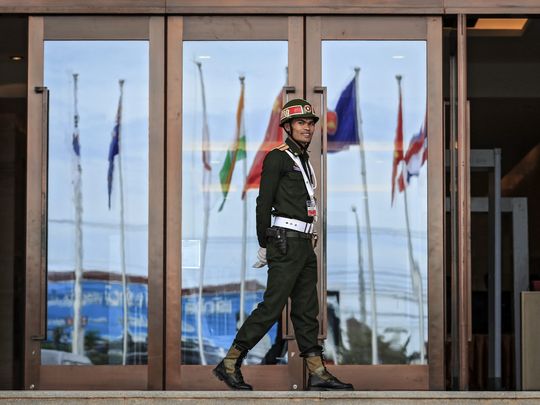VIENTIANE, Laos — This capital city, with its wide, tree-lined French colonial boulevards and old-fashioned tuk-tuk three-wheeled taxis, takes its turn in the international spotlight Monday, as Barack Obama becomes the first sitting U.S. president to travel here.
The sleepy, landlocked country of 6.8 million may well be the final Asian stop during his presidency. Obama arrives from the Group of 20 summit in Hangzhou, China, for a series of Asian summit meetings during the week.
Obama plans to push for closer economic ties with Laos and Southeast Asia, and other issues of international concern.
Philippine President Rodrigo Duterte, before he flew to Laos on Monday for the summit, warned Obama not to question him about extrajudicial killings — more than 2,000 suspected drug dealers and users have been killed since Duterte launched a war on drugs after taking office two months ago.
Duterte said Obama must not throw questions at him, or else, “son of a bitch, I will swear at you in that forum,” the Associated Press reported.
“Clearly he’s a colorful guy,” Obama said at a news conference in China when asked about Duterte’s comment.
Obama said he asked his staff to determine if meeting with Duterte while in Laos would still be productive.
The main topic for discussion with Laos’ leaders is sure to be unexploded ordnance, the legacy of a massive U.S. aerial campaign during the Vietnam War that dropped 270 million cluster bombs on the then officially neutral country to support the governing royal family against a Communist insurgency.
The White House said unexploded ordnance will be a focus of Obama’s visit, and it has signaled a stronger financial commitment to help clear deadly bombs that litter large swaths of the countryside.
Activists dealing with the problem see the president’s visit as an opportunity to bring it to the world’s attention. “We’re hoping for a strong multi-year commitment to clearance and victim assistance,” said Titus Peachey, board chairman of Legacies of War, an educational and advocacy group on the impact of Vietnam-era conflict.
Between 1964 and 1973, the U.S. conducted 580,000 bombing missions over Laos, partly as an effort to cut supply lines along the Ho Chi Minh Trail, a North Vietnamese supply chain that ran to South Vietnam.
An estimated 80 million of the baseball-sized cluster bombs —nearly a third of those dropped — failed to detonate. Less than 1% have been cleared and more than 20,000 people have been killed or injured since the bombing ceased.
Peachey said his organization is hoping for a $25 million annual commitment from the U.S. for 10 years. “We think that would be the amount needed to really make a significant impact on the clearance task,” he said. “We think there needs to be additional funding for victim assistance. There are about 12,000 to 15,000 surviving victims of cluster bombs and other ordnance accidents living in Laos and many of them need lifelong services.”
During the Obama administration, the U.S. has dramatically increased funding for bomb clearance, from about $2.5 million a decade ago to $19.5 for 2017. Thanks to the increased funds and new survey methods to uncover ordnance, the number of annual casualties has dropped significantly, from 310 in 2008 to just 42 in 2015.
For Obama, the visit is also a chance to strengthen economic ties with the formerly estranged country. “Given this president’s commitment to reach out to countries with whom we’ve had complicated histories, we see this as a real opportunity to…build a real working partnership that can benefit both of our peoples,” White House Press Secretary Josh Earnest said ahead of the trip.
Laos also can play a strategic role in the region as a member of ASEAN, the 10-member Association of Southeast Asian Nations, to help counter an increasingly assertive China in the region.
The visit “offers an opportunity for the U.S. leader to advance the so-called U.S. pivot to Asia” — Obama’s call for less emphasis on Europe, said Curtis S. Chin, former U.S. Ambassador to the Asian Development Bank and Asia Fellow at the Milken Institute, an economic think tank based in California.
“It is clear that a Chinese presence will continue to be felt in Laos and across Southeast Asia,” he said. “It is critical that U.S. engagement also continue in the region if a rules-based international order and U.S. economic leadership are to be sustained.”
China is already a major investor in Laos, with several large-scale projects in the works that range from special economic development zones at border areas to a $7 billion railway that is scheduled to link Vientiane with Kunming in southwestern China by 2020.
Source: USA Today



